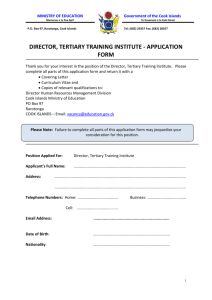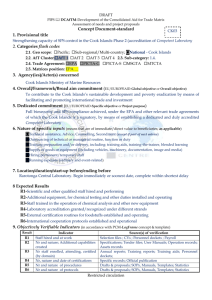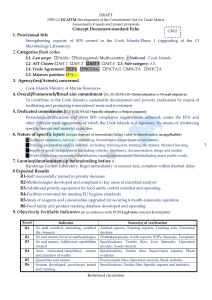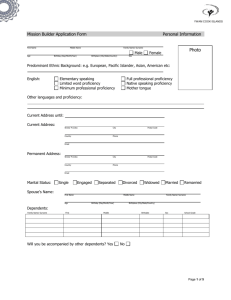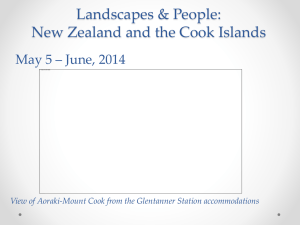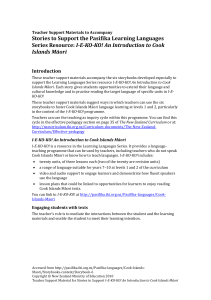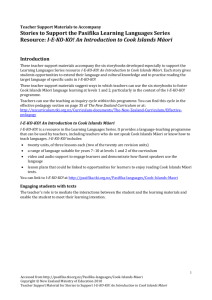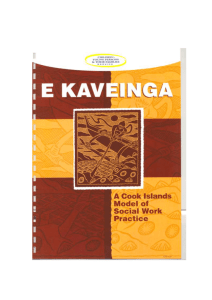Differentiate Teaching with my Cook Islands students 1
advertisement
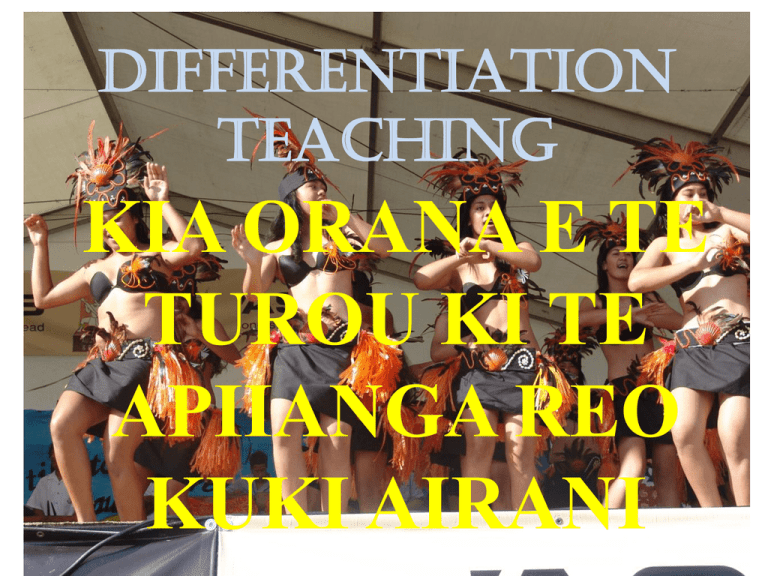
DIFFERENTIATION TEACHING KIA ORANA E TE TUROU KI TE APIIANGA REO KUKI AIRANI Differentiate Teaching In My Cook Islands Class. What worked when at Primary level. The students are smaller. The same students are in your class for a whole day so you can create learning centres. Students are grouped in all subjects. One teacher and with one routine. Consistency across the board and everything is integrated. The issues I face at Secondary. Working space Students are bigger Period changeovers/ time to set up the class. Subjects are specific – assessment driven. Timetable constraint. What works for my Cook Islands students? • Normally we start each lesson with the Lord’s Prayer in Cook Islands. • Establishing the routine in class from day one. • Roll call to be using the correct address to the teacher. • Teacher - “Popongi e __________” • Students – Popongi e Vavia tane (Mr Vavia) • Or can use the normal “Kiaorana” for greetings. How do I cater for their needs? At the beginning of the year the students fill in a survey sheet and thanks to the Tongan Language class for helping out with this. (Examples in the folder) WHAT RESOURCES AND STRATEGIES DO I USE IN CLASS? TEACHING AS ENQUIRY (example in the folder) Some examples of differentiation lessons. 1. Lesson prepared by colleagues at the Workshop. Focus: Different parts of the body in Cook Islands. Learning Outcome. By the end of this unit, students will be able to Describe people’s faces, hair, body Talk about hair and eye colours Identify pictures of people by listening to brief description Write a description of someone Perform a song in Cook islands language to do with body parts. How to group the students. Brainstorm of what the students already know about body parts in Cook Islands language. Choice of which tier they want to work on. • Tier 1. List of vocabularies for the unit. English and Cook Islands. Students to match them together. Labelling parts on a diagram of a human Knowing the basic body part song “Upoko pakuivi turi mangavaevae” Unscrambling the words of body parts. Eg. Ngtaria – taringa List of vocabs for colours to describe eyes and hair. • Tier 2. Constructing simple sentences using the body parts eg. Teia toku mata, Tena toou vaa, E rouru kerekere toku. Cloze activity – gaps for the body parts are left out. Start to include Parts of speech to the sentences. Matching body parts with actions. Describe people’s face or body parts. • Tier 3. Phrases and communicating with each other orally about their body parts. Personal stories of body parts. Using the five senses to include in their sentences eg. E ongi ana au ki toku putangio Clothes that you wear on different parts of the body. Eg. You wear socks on your vaevae. Write a description of someone. 2.Whole class approach o Give instructions and teaching with the whole class. o Students who are confident to move out and work independently. o Those that need extra help to remain in the group. This time the teacher simplifies the instructions and more examples are to be used. o Hopefully at the end you are left with the very, very needy ones. 3.Prepared speech • A choice of topics from the Cook Islands context eg My School, My Family, Cook Islands Culture etc... • They write a 2minutes speech and differentiate by telling the students that they can present their speech in: 1. English Only 2. 50/50 Cook Islands and English 3. Cook Islands only (confident speakers) 4.Writing a description of an old man. List of vocabularies to describe an old man. Translation in Cook Islands. Practice with pronunciation of words WRITING: (examples in the folder) 1. English only 2. 50 /50 English and Cook Islands (risk takers) 3. Cook Islands only (confident writers) 5. Making a Tivaevae Pattern – Cook Islands Art work (examples on the wall). Teacher discusses the importance of this art work and demonstrates the process. Students are given the choice to decide what patterns they will add to their work mainly focusing on tropical flowers and plants. Use a scrap paper to practice on. Check for the cutting. Choice of colours for their drawing. Enlarging on a bigger size paper. This time they need to keep the negative so they will have two finished products. Again a choice of what colours they want for the background and display. Lastly explain what their pattern represents either in English only, 50/50 or Cook Islands only. 6. Pronunciation of Cook Islands words. • Students are grouped with an expert in each group who has the roll of the leader. The students choose which group to be in. • With each unit we cover there are always new vocabularies to learn. • The teacher to get words ready on cards. • Share out cards to the groups. • Leader starts off first with two words – he/ she can either break the words in syllables or say the words out and the others repeat. • The leader gives 2 cards each for each student to do the same. • After each 5-7 minutes teacher to change cards around. KIAORANA E KIA MANUIA AND ENJOY YOUR WEEK-END
